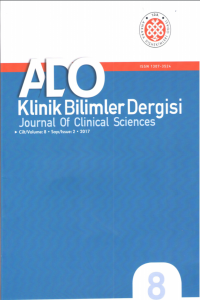Ortodontide Büyüme ve Gelişimin Değerlendirilmesi ve Önemi
Büyüme ve gelişim, ortodonti
Evaluation and Importance of Growth and Development in Orthodontics
orthodonticsGrowth and development,
___
- Burke FJ. Provisional restoration of veneer preparations. Dent Update. 1993;20:433-4.
- Sulieman MA. An overview of tooth-bleaching techniques: Chemistry, safety and efficacy. Periodontol 2000. 2008;48:148-69.
- Wray A, Welbury R. Treatment of intrinsic discoloration in permanent anterior teeth in children and adolescents. Int J Paediatr Dent. 2001;11:309-15.
- Sulieman M, Addy M, Rees JS. Development and evaluation of a method in vitro to study the effectiveness of tooth bleaching. J Dent. 2003;31:415-22.
- Weinstein AR. Esthetic applications of restorative materials and techniques in the anterior dentition. Dent Clin North Am. 1993;37:391-409.
- Goldstein RE, Garber DA, Goldstein CE, Schwartz CG, Salama MA, Gribble AR, Adar P, Ginsberg LJ. Esthetic update: The changing esthetic dental practice. J Am Dent Assoc. 1994;125:1447-56.
- Winkler D. Fundamentals of color: Shade matching and communication in esthetic dentistry. Br Dent J. 2005;199:59.
- Garber DA. Porcelain laminate veneers--to prepare or not to prepare? Compendium. 1991;12:178, 180-2.
- Magne P. Composite resins and bonded porcelain: The postamalgam era? J Calif Dent Assoc. 2006;34:135-47.
- Nakamura T, Imanishi A, Kashima H, Ohyama T, Ishigaki S. Stress analysis of metal-free polymer crowns using the three-dimensional finite element method. Int J Prosthodont. 2001;14:401-5.
- Alqahtani MQ. Tooth-bleaching procedures and their controversial effects: A literature review. Saudi Dent J. 2014;26:33-46.
- Lim CC. Case selection for porcelain veneers. Quintessence Int. 1995;26:311-5.
- Morley J, Eubank J. Macroesthetic elements of smile design. J Am Dent Assoc. 2001;132:39- 45.
- Freedman GA, McLaughlin G. Color Atlas of Porcelain Laminate Veneers. 1st ed. St. Louis, Mo.: Ishiyaku EuroAmerica; 1990. p.64-9.
- Crispin BJ. Indirect composite restorations: Alternative or replacement for ceramic? Compend Contin Educ Dent. 2002;23:611-24.
- Magne P, Belser UC. Porcelain versus composite inlays/onlays: Effects of mechanical loads on stress distribution, adhesion, and crown flexure. Int J Periodontics Restorative Dent. 2003;23:543- 55.
- Castelnuovo J, Tjan AH, Phillips K, Nicholls JI, Kois JC. Fracture load and mode of failure of ceramic veneers with different preparations. J Prosthet Dent. 2000;83:171-80.
- Tezvergil A, Lassila LV, Vallittu PK. Strength of adhesive-bonded fiber-reinforced composites to enamel and dentin substrates. J Adhes Dent. 2003;5:301-11.
- Calamia JR. The current status of etched porcelain veneer restorations. J Philipp Dent Assoc. 1996;47:35-41.
- Soares CJ, Santana FR, Fonseca RB, Martins LR, Neto FH. In vitro analysis of the radiodensity of indirect composites and ceramic inlay systems and its influence on the detection of cement overhangs. Clin Oral Investig. 2007;11:331-6.
- Asmussen E. Factors affecting the quantity of remaining double bonds in restorative resin polymers. Scand J Dent Res. 1982;90:490-6.
- Krejci I, Lutz F, Gautschi L. Wear and marginal adaptation of composite resin inlays. J Prosthet Dent. 1994;72:233-44.
- Spitznagel FA, Horvath SD, Guess PC, Blatz MB. Resin bond to indirect composite and new ceramic/polymer materials: A review of the literature. J Esthet Restor Dent. 2014;26:382-93.
- Karaarslan ES, Bulbul M, Ertas E, Cebe MA, Usumez A. Assessment of changes in color and color parameters of light-cured composite resin after alternative polymerization methods. Eur J Dent. 2013;7:110-6.
- Miyazaki T, Hotta Y, Kunii J, Kuriyama S, Tamaki Y. A review of dental CAD/CAM: Current status and future perspectives from 20 years of experience. Dent Mater J. 2009;28:44-56.
- Moörmann WH. The evolution of the CEREC system. J Am Dent Assoc. 2006;137 Suppl:7S- 13S.
- Liu PR, Essig ME. A panorama of dental CAD/ CAM restorative systems. Compend Contin Educ Dent. 2008;29:482-8.
- Jackson RD, Morgan M. The new posterior resins and a simplified placement technique. J Am Dent Assoc. 2000;131:375-83.
- Samet N, Kwon KR, Good P, Weber HP. Voids and interlayer gaps in class 1 posterior composite restorations: A comparison between a microlayer and a 2-layer technique. Quintessence Int. 2006;37:803-9.
- Sturdevant CM, Barton RE, Sockwell CL, Strickland WD. The Art and Science of Operative Dentistry. 2nd ed. St. Louis: C.V. Mosby; 1985. p.474.
- Nakamura M, Matsumura H. The 24-year clinical performance of porcelain laminate veneer restorations bonded with a two-liquid silane primer and a tri-n-butylborane-initiated adhesive resin. J Oral Sci. 2014;56:227-30.
- Robbins JW. Color characterization of porcelain veneers. Quintessence Int. 1991;22:853-6.
- El-Askary FS, El-Banna AH, van Noort R. Immediate vs delayed repair bond strength of a nanohybrid resin composite. J Adhes Dent. 2012;14:265-74.
- Sideridou ID, Karabela MM, Micheliou CN, Karagiannidis PG, Logothetidis S. Physical properties of a hybrid and a nanohybrid dental light-cured resin composite. J Biomater Sci Polym Ed. 2009;20:1831-44.
- Başeren M. Surface roughness of nanofill and nanohybrid composite resin and ormocer-based tooth-colored restorative materials after several finishing and polishing procedures. J Biomater Appl. 2004;19:121-34.
- Burgoyne AR, Nicholls JI, Brudvik JS. In vitro two-body wear of inlay-onlay composite resin restoratives. J Prosthet Dent. 1991;65:206-14.
- St-Georges AJ, Sturdevant JR, Swift EJ Jr, Thompson JY. Fracture resistance of prepared teeth restored with bonded inlay restorations. J Prosthet Dent. 2003;89:551-7.
- Luhrs AK, Pongprueksa P, De Munck J, Geurtsen W, Van Meerbeek B. Curing mode affects bond strength of adhesively luted composite CAD/CAM restorations to dentin. Dent Mater. 2014;30:281- 91.
- Felippe LA, Baratieri LN. Direct resin composite veneers: Masking the dark prepared enamel surface. Quintessence Int. 2000;31:557-62.
- Boening KW, Wolf BH, Schmidt AE, Kastner K, Walter MH. Clinical fit of Procera AllCeram crowns. J Prosthet Dent. 2000;84:419-24. Dr. Serkan GÖRGÜLÜ
- ISSN: 1307-3540
- Yayın Aralığı: Yılda 3 Sayı
- Başlangıç: 2006
- Yayıncı: Ankara Diş Hekimleri Odası
Endodontide Biyoseramik İçerikli Tamir Materyallerine Güncel Bir Bakış
Ortodontide Büyüme ve Gelişimin Değerlendirilmesi ve Önemi
Mehmet Uğur OFLAZ, Serkan GÖRGÜLÜ
Panoramik Radyografta Tespit Edilen İzole Hyoid Kırığı: Olgu Sunumu
Migration of a Dental Implant into the Maxillary Sinus
Onur ŞAHİN, Onur ODABAŞI, Mehmet Emrah POLAT
Diş Hekimliğinde Üçlü Antibiyotik Patın Kullanımı
Abidin T MUTLUAY, Merve MUTLUAY
Diş Hekimliğinde Yeni Bir Materyal: Giomerler
Dental Anksiyetede Durumluk ve Sürekli Kaygı Ölçeğinin Kullanımı
